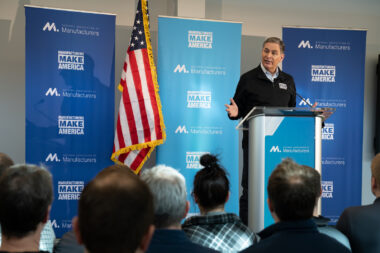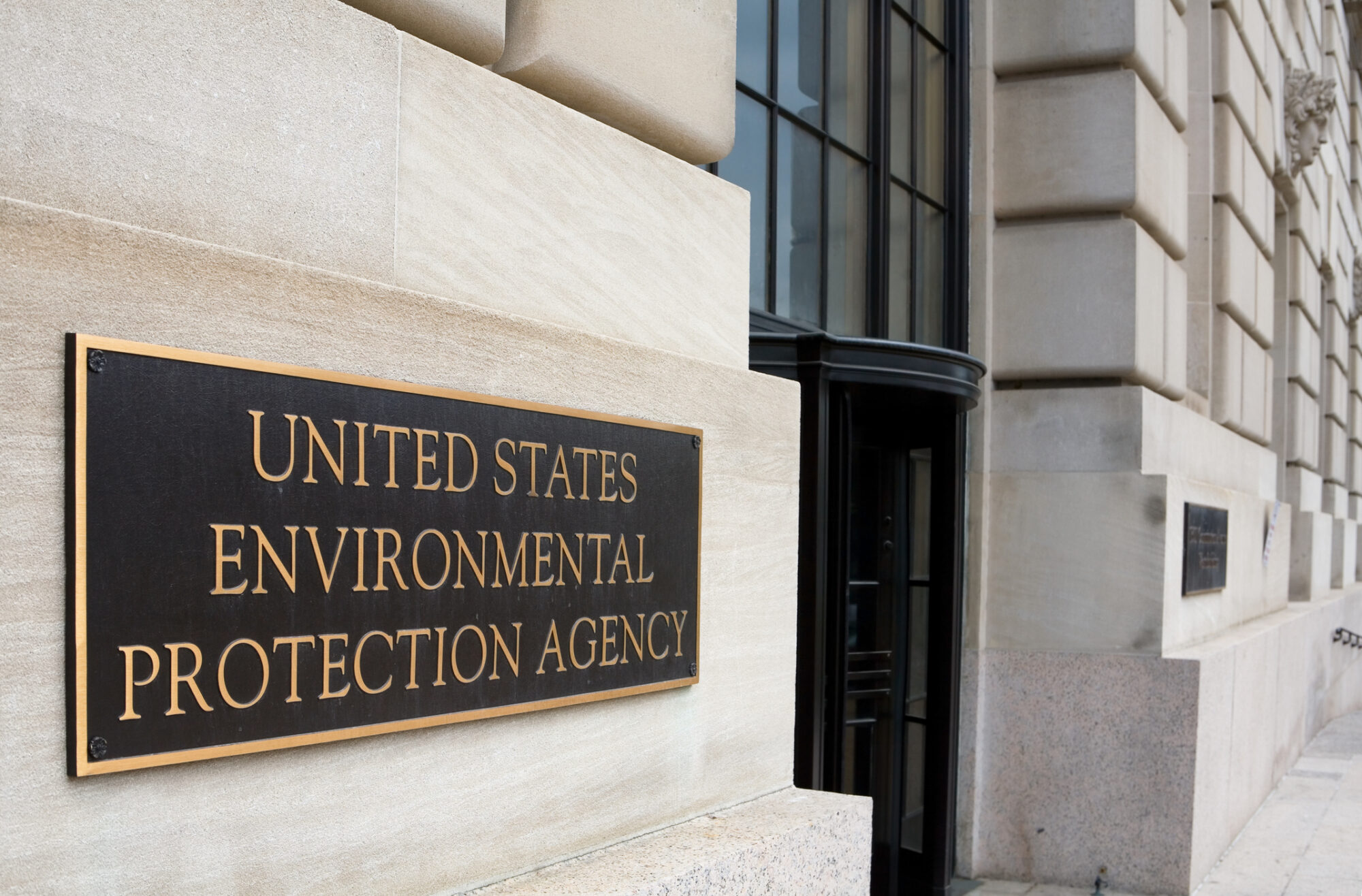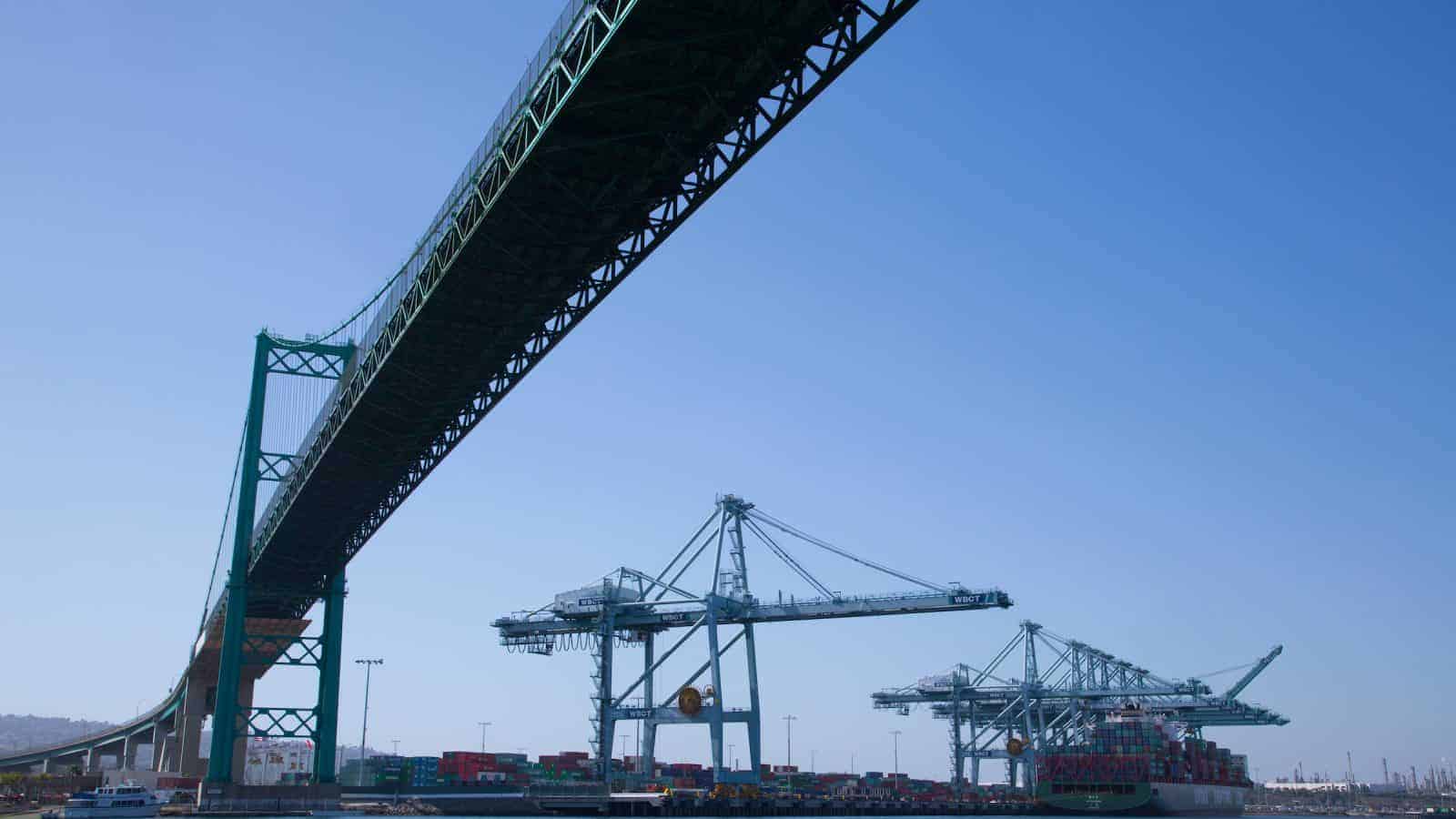Manufacturers Push Back on Harmful EPA Air Proposal
Washington, D.C. – Following the National Association of Manufacturers comment submission to the Environmental Protection Agency on its proposed rule to impose more stringent National Ambient Air Quality Standards for Particulate Matter 2.5., NAM Director of Energy and Resources Policy Chris Morris released the following statement:
“Improving air quality in the U.S. is a key priority for manufacturers, which is why they have invested heavily in new processes and technologies that have made manufacturing cleaner and more sustainable than ever. These efforts have contributed to the U.S. successfully achieving some of the lowest levels of exposure to PM 2.5 globally, including lower PM 2.5 levels than France, Germany, Japan and the U.K.
“The EPA’s proposal would significantly increase the number of industrial centers and population hubs in nonattainment areas. That could halt new investment, stop operations in some circumstances and cost jobs.
“Significantly, the NAM’s Outlook Survey for the first quarter of 2023 found that more than 55 percent of manufacturers anticipate the new standard would raise their cost of compliance, and one out of three manufacturers anticipate that the new standards would lead to increased permitting challenges and restrict investment and facility expansion plans.
“The NAM urges EPA to maintain the existing standard as its proposal will hinder domestic manufacturing growth, does not adequately assess the economic and job consequences or identify feasible steps to achieve attainment with new standards.”
-NAM-
The National Association of Manufacturers is the largest manufacturing association in the United States, representing small and large manufacturers in every industrial sector and in all 50 states. Manufacturing employs nearly 13 million men and women, contributes $2.81 trillion to the U.S. economy annually and accounts for 55% of private-sector research and development. The NAM is the powerful voice of the manufacturing community and the leading advocate for a policy agenda that helps manufacturers compete in the global economy and create jobs across the United States. For more information about the NAM or to follow us on Twitter and Facebook, please visit www.nam.org.
The NAM Revives High-Level U.S.–U.K. Talks

The NAM’s Competing to Win Tour in Europe moved on to London early this week, highlighting the imperative to shore up the U.S.–U.K. relationship—and to urgently address other barriers, like permitting reform and workforce shortages, to enable the U.S. to help allies in the face of Russian aggression and other geopolitical threats.
The issue: Russia’s unprovoked war in Ukraine, the aftermath of the worldwide pandemic and China’s quest for global leadership create a new urgency for expanded trade opportunities between democratic countries.
- The U.S. and the U.K. must work together to shore up supply chains, enhance energy security, boost resiliency and create growth, as NAM President and CEO Jay Timmons emphasized.
The details: Timmons crisscrossed London on Monday and Tuesday, promoting the manufacturing industry and reinforcing its priorities with senior government ministers and officials, including:
- Nigel Huddleston MP, the U.K. minister of state for international trade
- Jonathan Reynolds, Labour Party shadow business secretary (one of the architects of the Labour Party’s industrial plan)
- Jane Hartley, U.S. Ambassador to the Court of St. James’s
Support at home: During his visit, Timmons did an interview with CNN International to discuss the NAM’s new Outlook survey, which found that 77% of manufacturers want to see more trade agreements with Europe.
Making industry connections: At the NAM’s sister organization Make UK, Timmons joined a roundtable with CEO Stephen Phipson and addressed some of Britain’s leading manufacturing companies.
- He spoke about how the U.S. and the U.K. can unlock new trading opportunities going forward and bolster democracy by strengthening commerce.
- The two groups also reaffirmed their commitment to share market intelligence, data and policy work, as well as to facilitate visits for economic delegations promoting trade, investment and commercial opportunities.
- They also voiced their continued and mutual support of the Ukrainian people and of the democratic institutions in their own countries.
What they said: “The ties between the UK and United States go back a long way and we have significant political, economic and trade connections,” said Phipson. “Relations with the US are vital and its market is the second most important for UK goods. In a post-Brexit world, it is likely to assume ever greater importance as part of our efforts to boost global trade.”
- “As world events have made abundantly clear, strengthening democracy, the free enterprise system and strategic alliances in our countries and around the world is essential to our future and the fight against tyranny,” said Timmons. “As the U.S. and the U.K. take steps to build a stronger, more open and secure economic relationship, the NAM urges our leaders to move toward a new U.S.–U.K. market-opening trade agreement that includes strong, clear and enforceable outcomes.”
Meeting manufacturers: In addition, Timmons met with manufacturers that have operations or pending operations in both the U.K. and the U.S. Energy security and regulatory certainty, as well as the worker shortage in the industry, also took center stage in these discussions.
Bottom line: “The tour’s time in London matters to manufacturers in the United States because it strengthens the ‘special relationship’ between the U.S. and the U.K. and boosts the prospects for enhanced cross-Atlantic trade, supporting manufacturing jobs in both countries,” said Ken Monahan, NAM Vice President of International
Timmons: We Have to Get Serious About Competing with China; The President’s Budget Does the Opposite
Washington, D.C. – National Association of Manufacturers President and CEO Jay Timmons released the following statement on President Biden’s fiscal 2024 budget plan:
“There is no escaping the fact that the tax increases in President Biden’s new budget proposal would reverse the recent significant growth we’ve achieved in American manufacturing jobs and investment.
“After the 2017 tax reform made rates more competitive, manufacturers kept their promises to raise wages and invest in their communities. In fact, 2018 was the best year for manufacturing job creation in the previous 21 years. And in the past two years, as we rebuilt from the pandemic, we’ve created more jobs in the sector than at any point since the Reagan administration. So it comes as a surprise that President Biden, who has vocally championed manufacturing growth in pushing successfully for infrastructure investment and the CHIPS and Science Act, wants to pursue policies that would undo our progress.
“We have to get serious about competing with China; the president’s budget does the opposite. This proposal further undermines manufacturing in America by failing to reverse tax policies that make it more difficult for our industry to perform research, while China currently employs a 200% super deduction on R&D for manufacturing. It’s also now more expensive to buy critical machinery and finance new investments. If these lapsed deductions aren’t reinstated, it will mean lost jobs, less innovation and fewer opportunities for our communities.
“As manufacturers work to lead our economy forward, we also remain committed to lowering health care costs through market-based solutions that deliver choice and flexibility. Unfortunately, this administration’s insistence on imposing drug pricing requirements is an abdication of free market principles that poses serious risks to the development of new treatments and therapies—the very type of innovation that saves lives in America and around the world.
“Manufacturers are committed to growing investment, jobs and wages here in America. We need our government leaders to share that commitment.”
Background: Read more about how these critical tax priorities impact manufacturers across the country here.
-NAM-
The National Association of Manufacturers is the largest manufacturing association in the United States, representing small and large manufacturers in every industrial sector and in all 50 states. Manufacturing employs nearly 13 million men and women, contributes $2.81 trillion to the U.S. economy annually and accounts for 55% of private-sector research and development. The NAM is the powerful voice of the manufacturing community and the leading advocate for a policy agenda that helps manufacturers compete in the global economy and create jobs across the United States. For more information about the NAM or to follow us on Twitter and Facebook, please visit www.nam.org.
Timmons: Biden’s Visit Shows the World That the U.S. Stands with the Ukrainian People
Washington, D.C. – National Association of Manufacturers President and CEO Jay Timmons released the following statement on President Biden’s visit to Ukraine:
“President Biden’s visit to Ukraine the week of the anniversary of Russia’s brutal and unprovoked invasion shows the world that the United States stands with the Ukrainian people and that our support is unwavering.
“The struggle in Ukraine is more than a war between two countries. It’s a struggle between freedom and tyranny. Manufacturers believe that there are two systems evolving in this world—one that enriches lives and lifts people up into freedom and prosperity, and the other that is oppressive and robs people of their liberty. We must continue to support the Ukrainian people, ensuring that critical supplies keep moving and investing in and rebuilding this war-torn country.
“Manufacturers in the U.S. have a long and proud history of standing firm in support of democracy, the rule of law, transparency, freedom and opportunity. The NAM and our members have demonstrated our unwavering support for Ukraine and its people, and the NAM spoke out firmly against the war with our Board of Directors passing unanimously a resolution at our meeting in March 2022. We supported sanctions against Russia, called for the suspension of Permanent Normal Trade Relations with Russia and mobilized humanitarian relief to Ukraine. Additionally, the NAM’s Emergency Response Committee has worked with NAM members and Project HOPE to support the resettlement of Ukrainians in the U.S. As an industry, we are committed to working with our partners to ensure that the Ukrainian people have the support they need to build a future of freedom and prosperity.”
-NAM-
The National Association of Manufacturers is the largest manufacturing association in the United States, representing small and large manufacturers in every industrial sector and in all 50 states. Manufacturing employs nearly 13 million men and women, contributes $2.81 trillion to the U.S. economy annually and accounts for 55% of private-sector research and development. The NAM is the powerful voice of the manufacturing community and the leading advocate for a policy agenda that helps manufacturers compete in the global economy and create jobs across the United States. For more information about the NAM or to follow us on Twitter and Facebook, please visit www.nam.org
WATCH: 2023 State of Manufacturing Address
Presented by Jay Timmons, President and CEO of the National Association of Manufacturers, the 2023 State of Manufacturing Address was given from Husco International in Waukesha, Wisconsin. Special remarks were given by Kurt Bauer, President and CEO, Wisconsin Manufacturers & Commerce. Special thanks to Husco President and CEO Austin Ramirez and his team for hosting this year’s address.
Read the official remarks here.

We’re hitting the road. This year’s NAM State of Manufacturing Address officially kicked off the 2023 leg of the NAM’s Competing to Win Tour. The tour will continue to spotlight the industry’s rapid transformation, while also focusing on manufacturing’s well-paying careers, diverse workforce and real-world solutions for the industry’s continued growth.
Upcoming stops: Waukesha and Pewaukee, Wisconsin (Tue, Feb 21); Fishers, Indiana (Wed, Feb 22); Harahan and Avery Island, Louisiana (Thurs, Feb 23)

NAM Launches 2023 Competing to Win Tour
President and CEO Jay Timmons to Deliver the NAM State of Manufacturing Address
Washington, D.C. – The National Association of Manufacturers will kick off its 2023 Competing to Win Tour on Tuesday, Feb. 21, 2023, traveling to three states and visiting four manufacturing facilities along the way.
The tour will begin in Wisconsin, where NAM President and CEO Jay Timmons will deliver the 2023 NAM State of Manufacturing Address at Husco.
Throughout the week, Timmons will join local manufacturers, employees, media, community leaders and elected officials to discuss the challenging environment facing manufacturers and the urgent need for solutions on issues including immigration reform, permitting reform, workforce development, tax policy and more.
The tour comes as nearly two-thirds of manufacturers are concerned about the challenging economic environment characterized by inflation, supply chain disruption and the workforce crisis, according to the NAM’s latest Manufacturers’ Outlook Survey. More than three-quarters of respondents said pushing back against regulatory overreach should be the top priority of the 118th Congress.
“Our focus on this tour is telling the story of resilient, modern manufacturing—and the tools we need from policymakers to continue leading our economy forward and making the world a better place,” said Timmons. “To unleash our full potential, we need to reinstate critical tax provisions, a smarter, balanced approach to regulations, immigration reform and significant permitting reform, and reject top-down air regulations that cost jobs and snarl supply chains.”
For more than a decade, the annual NAM State of Manufacturing Address has focused the nation’s attention on the industry that is the backbone of the American economy, highlighting the 13 million men and women who are building our future.
The NAM has frequently traveled the country, bringing policy discussions and conversations about the future of work to shop floors, schools, economic clubs, televisions studios, the White House and more.
At a time when the future of work is top of mind for workers and thought leaders alike, the tour will also spotlight the industry’s rapid transformation, while also focusing on manufacturing’s well-paying careers, the industry’s diverse workforce and the real-world solutions for manufacturing’s continued growth.
Tour events will take place in Wisconsin, Indiana and Louisiana. Details are as follows:
Tuesday, Feb. 21 // Wisconsin
8:30 a.m. – 10:30 a.m. CST
Husco
2239 Pewaukee Road
Waukesha, Wisconsin 53188
11:00 a.m. – 12:00 p.m. CST
Waukesha County Technical College
800 Main Street
Pewaukee, Wisconsin 53072
Wednesday, Feb. 22 // Indiana
9:00 a.m. – 11:00 a.m. EST
INCOG BioPharma Services
12050 Exit 5 Parkway
Fishers, Indiana 46037
Timmons will be joined by Sen. Todd Young (R-IN)
Thursday, Feb. 23 // Louisiana
8:30 a.m. – 10:00 a.m. CST
Laitram
200 Laitram Lane
Harahan, Louisiana 70123
2:00 p.m. – 3:30 p.m. CST
McIlhenny Company
Highway 329
Avery Island, Louisiana 70513
MEDIA RSVP: Members of the media interested in covering the tour or attending an event should contact [email protected].
-NAM-
The National Association of Manufacturers is the largest manufacturing association in the United States, representing small and large manufacturers in every industrial sector and in all 50 states. Manufacturing employs nearly 13 million men and women, contributes $2.81 trillion to the U.S. economy annually and accounts for 55% of private-sector research and development. The NAM is the powerful voice of the manufacturing community and the leading advocate for a policy agenda that helps manufacturers compete in the global economy and create jobs across the United States. For more information about the NAM or to follow us on Twitter and Facebook, please visit www.nam.org.
NAM to EPA: Reverse WOTUS Rule

The Environmental Protection Agency’s recently issued rule governing regulation of “navigable waters” is unnecessary, confusing and inconsistent—and the NAM stands ready to work with Congress to overturn it.
The background: In December, the EPA and the U.S. Army Corps of Engineers announced the new regulation, which repealed the Navigable Waters Protection Rule and altered the definition of “Waters of the United States.”
- This month, House Transportation and Infrastructure Committee Chairman Sam Graves (R-MO) introduced a joint resolution of disapproval of the rule under the Congressional Review Act. An identical measure was introduced in the Senate.
- The NAM this week hailed the congressional moves. “Manufacturers welcome action from Congress to challenge the EPA’s proposed WOTUS Rule,” said NAM President and CEO Jay Timmons.
What’s going on now: Ahead of a Transportation and Infrastructure Committee hearing Wednesday, NAM Senior Director of Energy and Resources Policy Nile Elam urged the “educat[ion of] the public and policy stakeholders regarding the immense permitting regulatory efforts necessary under local and state jurisdictions, and the need for a complementary WOTUS rule that advances permitting protections at the federal level while providing certainty for the regulated community.”
- Though many Supreme Court decisions have “touched on” the definition of navigable waters, neither the court nor the EPA has clarified sufficiently, Elam told Water Resources and Environment Subcommittee Chairman David Rouzer (R-NC) and Ranking Member Grace Napolitano (D-CA).
- The new rule also “expands federal jurisdiction beyond traditional navigable waters,” Elam said. “Because of these expansions and ambiguous terms, the careful balance between local and state regulators is unpredictable and can leave permit seekers with little guidance, aside from the need for more time and money to achieve their permitting requests.”
What should come next: Congress must work with stakeholders, the EPA and the Corps on creating clear, predictable and common-sense WOTUS regulations, Elam told the committee. Doing so will “enhanc[e] manufacturers’ ability to deliver their goods, expand their operations and grow their workforce.”
Timmons: America’s Success and Leadership Depend on a Strong, Competitive Manufacturing Industry
Washington, D.C. – National Association of Manufacturers President and CEO Jay Timmons released the following statement in response to President Biden’s 2023 State of the Union address:
“President Biden rightly celebrated the significant growth and job creation that manufacturers have achieved in these past two years. Indeed, more manufacturing jobs have been created in the first two years of the Biden administration than at any point since the Reagan administration. Like his recent predecessors, he recognizes manufacturing’s vital role in our economy and our country. America’s success and leadership depend on a strong, competitive manufacturing industry.
“The President should be commended for the historic, bipartisan accomplishments of the past two years—including the infrastructure law and the CHIPS and Science Act. These measures are already making life better and spurring new manufacturing jobs. We agree with President Biden that there is now an urgent need to build on that progress by tackling immigration reform in a smart, bipartisan way. There are millions of people ready to work in the U.S., and manufacturers have hundreds of thousands of unfilled jobs. Not only is the broken immigration system creating a border crisis, but it is also standing in the way of a stronger economy for every American.
“However, the President misses the mark in not recognizing that the historic tax reforms of 2017 and the previous administration’s efforts to promote regulatory certainty helped lay the foundation for the recent success in creating jobs, increasing investment and raising wages. Instead of the Biden administration’s misguided suggestions for restrictions on pharmaceutical innovation and for destructive tax increases, Congress should immediately reinstate critical tax deductions for the costs of research, machinery purchases and key business investments. Restoring these tools is essential to keep up the pace of manufacturing job creation and to out-innovate and outcompete China. And to truly unleash manufacturing investment, fully realize the potential of the infrastructure law and achieve energy security in America, we need a smarter, balanced approach to regulations and significant permitting reform so that projects don’t languish for years in a bureaucratic mess just waiting for government approvals. After all, manufacturers are already making great strides in reducing emissions. Now is not the time to add top-down air regulations that will cost us jobs and snarl supply chains.
“The State of the Union address is one of the sacred traditions of our democracy. And as we approach the one-year mark of Russia’s war on Ukraine, we are reminded just how precious those traditions and our institutions are. Democracy is the foundation of the values that keep our industry strong and have made America exceptional—free enterprise, competitiveness, individual liberty and equal opportunity. And that is why manufacturers stand firm in our belief that democracy must be respected, protected and defended at home and abroad.”
Background: The NAM’s “Competing to Win” policy agenda for manufacturing competitiveness can be found here. Its in-depth proposal for immigration reform, “A Way Forward,” is available here. In the NAM’s most recent Manufacturers’ Outlook Survey, two-thirds of manufacturers said that immigration reform should be a priority for the 118th Congress.
-NAM-
The National Association of Manufacturers is the largest manufacturing association in the United States, representing small and large manufacturers in every industrial sector and in all 50 states. Manufacturing employs nearly 13 million men and women, contributes $2.81 trillion to the U.S. economy annually and accounts for 55% of private-sector research and development. The NAM is the powerful voice of the manufacturing community and the leading advocate for a policy agenda that helps manufacturers compete in the global economy and create jobs across the United States. For more information about the NAM or to follow us on Twitter and Facebook, please visit www.nam.org.
Timmons: Debt Ceiling Uncertainty Will Derail Manufacturing Growth
Manufacturers Call on Administration and Congress to Act Swiftly
Washington, D.C. – National Association of Manufacturers President and CEO Jay Timmons released the following statement regarding negotiations to raise the debt ceiling:
“It is imperative that Congress and the administration reach a resolution to the debt limit issue as swiftly as possible. Waiting to act until extraordinary measures are exhausted constitutes dangerous brinkmanship that would inject uncertainty into the global economy and increase the risk of a default that would derail manufacturing growth in America, tank markets and put jobs at risk.
“We did not become the greatest nation in the world by shirking our responsibilities. Manufacturers have been working overtime to rebuild our economy, strengthening supply chains, creating jobs at record rates and helping defend against threats from around the world. All of those achievements will be erased if the United States does not find a path forward on the debt limit and fiscal responsibility. Let’s rise above this challenge so that manufacturers can do what we do best: improve lives and livelihoods here and around the world.”
-NAM-
The National Association of Manufacturers is the largest manufacturing association in the United States, representing small and large manufacturers in every industrial sector and in all 50 states. Manufacturing employs more than 12.9 million men and women, contributes $2.81 trillion to the U.S. economy annually and accounts for 55% of private-sector research and development. The NAM is the powerful voice of the manufacturing community and the leading advocate for a policy agenda that helps manufacturers compete in the global economy and create jobs across the United States. For more information about the NAM or to follow us on Twitter and Facebook, please visit www.nam.org.
Congress Fails to Advance Manufacturing Tax Priorities
Bipartisan Provisions Like R&D Incentives Are Critical to Small Manufacturers’ Ability to Invest
Washington, D.C. – The National Association of Manufacturers is calling on lawmakers to immediately address critical tax provisions that were left out of the 2023 Omnibus spending package, highlighting the negative impact to small manufacturers and their workers.
“Congress’ failure to reverse tax policies that make it more costly to perform research, buy machinery and finance job-creating investments has put hundreds of thousands of American jobs and manufacturing competitiveness at risk. Despite overwhelming support for addressing these issues, Congress’ inaction will now undercut small manufacturers’ ability to invest in their workers, facilities and communities,” said NAM President and CEO Jay Timmons.
Ketchie President and Owner and Incoming Chair of the NAM Small and Medium Manufacturers Group Courtney Silver recently highlighted that congressional action on these tax priorities will help prevent small manufacturers from feeling “stuck between a rock and a hard place. It’s very important that we take action on expanding and locking in that pass-through deduction, increasing those incentives around R&D and protecting those provisions around full expensing and interest deductibility,” said Silver.
“Although the appropriations package included important manufacturing priorities, including the INFORM Consumers Act, with its protections for consumers against counterfeit goods, and the Electoral Count Reform Act, which supports a clear and secure democratic process, pro-competitiveness tax policy changes would have made a big difference for businesses of all sizes across our industry,” continued Timmons. “As the next Congress convenes, we urge lawmakers to prioritize these policies, and we will continue to work with manufacturing champions from both parties to provide tax certainty to the nearly 13 million people who work in manufacturing today.”
Read more about how these critical tax priorities impact small manufacturers across the country here.
-NAM-
The National Association of Manufacturers is the largest manufacturing association in the United States, representing small and large manufacturers in every industrial sector and in all 50 states. Manufacturing employs more than 12.9 million men and women, contributes $2.77 trillion to the U.S. economy annually and accounts for 55% of private-sector research and development. The NAM is the powerful voice of the manufacturing community and the leading advocate for a policy agenda that helps manufacturers compete in the global economy and create jobs across the United States. For more information about the NAM or to follow us on Twitter and Facebook, please visit www.nam.org.
